Five years ago, one early morning, I woke up to the red alert sound at the exchange. In just three hours, my account with 6 million in assets was completely liquidated, leaving me with nothing. I watched the negative numbers constantly jumping on the computer screen, feeling like I was nailed to the cross of reality!
In the end, I understood: the cryptocurrency market is not a casino, but a battlefield. I borrowed 120,000 in capital from friends, constantly summarized failed cases, learned various trading skills, strategies, and chart watching, and summarized a trading method with a win rate as high as 90%. It took me 90 days to grow the capital to 20 million. It was really not easy!
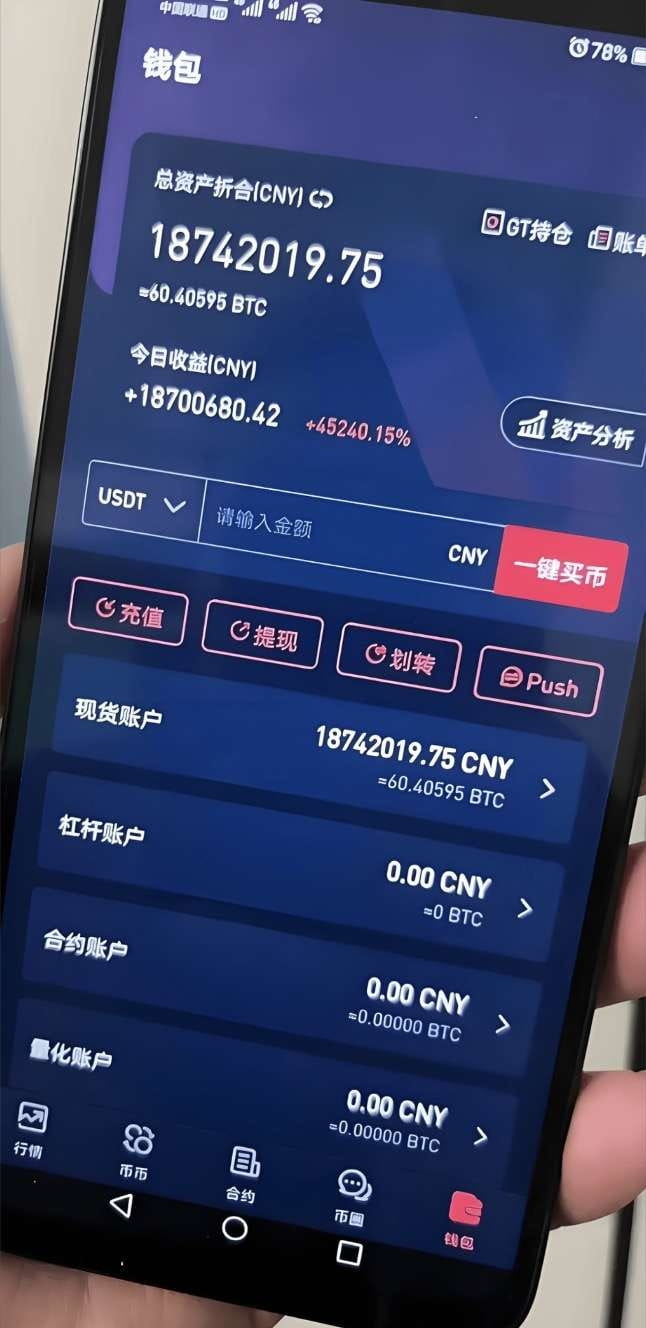
In addition to solid naked candlestick techniques, I also strictly follow these 10 ironclad rules of trading.
1. Buy early when prices drop, sell early when prices rise: When you see a significant drop in coin prices, there is no need to panic; it may be a good opportunity to enter. When coin prices rise significantly, be alert to possible pullbacks and reduce positions accordingly. Capturing market fluctuations is key to achieving stable profits.
2. Capital allocation: Capital allocation is a key factor in determining profit. It should be allocated reasonably based on one's risk tolerance and market conditions. Pursue higher returns while ensuring safety.
3. Afternoon Strategy: If coin prices continue to rise in the afternoon, do not blindly chase highs and try to avoid high positions; if a sudden drop occurs, first observe the market reaction, and do not rush to bottom fish. Wait until the market stabilizes before making a decision.
4. Stay calm: Market volatility is intense, and emotional management is crucial. Don't panic when prices drop in the morning, take appropriate breaks during consolidation, and maintain calmness without being swayed by emotions.
5. Follow the trend: Do not rush to operate when the trend is unclear. Do not sell when the price has not set a new high, do not buy when there is no pullback, and wait patiently during consolidation. Do not easily enter the market.
6. Yin-Yang Line Strategy: Choose bearish lines when buying for more stability; wait for bullish lines to appear when selling to obtain higher profits.
7. Contrarian Thinking: Going with the trend is a conventional strategy, but in certain situations, contrarian operations may also bring opportunities. Daring to challenge market rules can lead to greater profits.
8. Patiently wait for opportunities: When coin prices hover in a high-low range, do not be eager for quick success. Patiently wait for the market to show a clear trend before acting to ensure more stability.
9. Risks after high-level consolidation: If the coin price suddenly rises after consolidating at a high level, be alert to the risk of a pullback. In this case, reducing positions or decisively exiting is an effective method to avoid being trapped.
10. Hammer doji warning: The hammer doji pattern signals a turning point in the market. When encountering this pattern, stay alert, avoid full-position operations, and controlling risk is the way to be stable.
First, let's understand what naked candlestick technology is.
When entering the market to trade, many friends like to refer to 'technical indicators' as a basis for buying and selling. Such as MACD red-green bars, KDJ golden cross and death cross, moving average support, etc.
Many friends even go around searching for a 'holy grail indicator', thinking that as long as they have it, they can earn big money without worry. However, you simply cannot find such a 'holy grail indicator'.
In fact, almost all of these technical indicators are obtained through statistical processing of historical market prices or trading volumes. Many times you will find that price leads indicators; indicators usually have relative lag.
Price has risen significantly, indicators have shown a golden cross, or prices have dropped significantly before a death cross appears, these phenomena are the drawbacks of indicators.
The naked candlestick technique we are sharing today is the most direct reflection of market behavior (price) trading method. By analyzing market behavior (price charts), that is, using the structure of candlestick charts for trading methods.
The application of price action trading methods is completely based on market behavior (price) itself, analyzing past price performance to predict future trends.
Therefore, under normal circumstances, we only use candlestick charts for judgment and analysis. Thus, the price action trading method is to infer price trends by observing naked candlestick charts, without the use of any other technical indicators.
In our view, the candlestick chart is the most expensive 'artwork' in the world. If you can understand the candlestick chart, you can continuously acquire wealth in this market.
Next, let me teach you how to appreciate this 'artwork'!
First step: we need to understand 'market structure.'
There is a saying: birds have their languages, and beasts have their sounds. The secondary trading market of cryptocurrencies also has its language; the candlestick chart is like letters. If you can read it, you can make predictions about the future market.
For the red and green bars on the naked candlestick chart, a recursive process can be established from a single candlestick - candlestick combination - pattern - market trend structure.
First, look at a single candlestick.
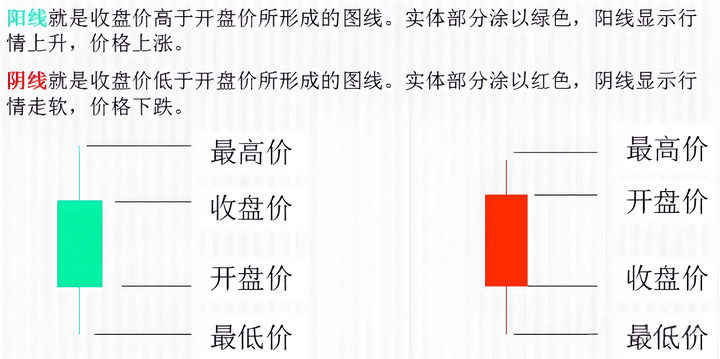
A single candlestick is composed of four prices: opening price, closing price, highest price, and lowest price. It represents the struggle of bulls and bears within a certain time unit, ultimately distinguished by bearish and bullish columns (red-green bars). These basic concepts do not require excessive explanation here.
The size of a single candlestick represents different meanings. Large bullish candlesticks, medium bullish candlesticks, and small bullish candlesticks all represent price increases, but the intensity of bullish forces decreases in order. The small bullish candlestick indicates that bullish and bearish forces are at a stalemate, creating a tense situation.
The same goes for large bearish candlesticks, medium bearish candlesticks, and small bearish candlesticks.
Candlesticks with long shadows: shooting star, hammer, inverted hammer, hanging man.
They exhibit features: short bodies, long shadows; often the shadow is more than twice the body; the secondary shadow or reverse shadow is very short.
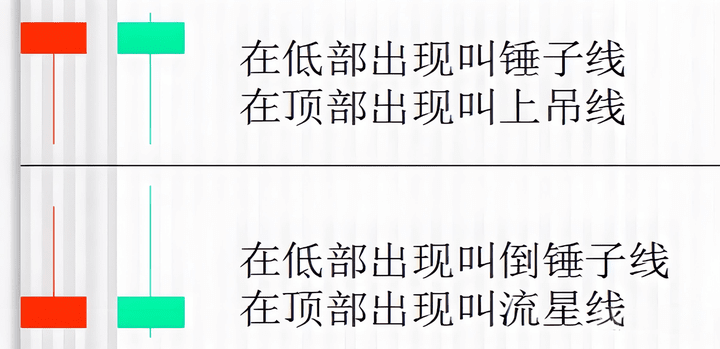
In the first group of single candlestick patterns in the chart, regardless of bullish or bearish (red or green), if it appears at the bottom, it is called a hammer; if it appears at the top, it is called a hanging man. The second group of candlestick patterns, regardless of bullish or bearish, if it appears at the bottom, it is called an inverted hammer; if it appears at the top, it is called a shooting star.
These types of candlesticks represent a stalemate between bulls and bears, and often the appearance of such candlesticks is a reversal signal. Of course, a single candlestick can also be confirmed further by combining with the preceding and following candlestick combinations to verify the effectiveness of the reversal signal. The specific direction of the rise or fall they represent needs to be analyzed comprehensively based on their position.
For instance, a shooting star at the top indicates a strong willingness and determination of the bears, and the subsequent probability of a decline is high. In this case, it is basically possible to short, effectively preserving value.
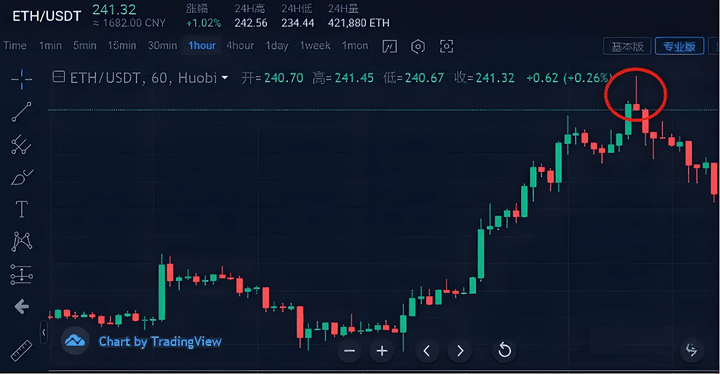
This is the shooting star pattern that appeared in ETH's hourly movement in mid-July this year.
The application in cycles generally applies to periods above 1 hour, and the longer the cycle, the greater the reversal space. If it is in the 1-minute or several minutes level, although the principle is the same, it is easy to produce false signals, and its timeliness will be relatively short.
What is the underlying principle behind this peak? Let's analyze it:
The upper shadow reflects that the bullish forces have weakened during this period. If the body closes bearish, it indicates that the bearish forces ultimately closed down after a struggle; if the body is bullish, it means that despite the closing price being higher than the opening price, it also reflects that the bearish forces are gaining strength. It may seem that the price is rising, but it actually indicates that the trend may turn downward.
At the same time, the longer the shadow, the more intense the bearish competition. When this candlestick pattern appears at a stage top, it indicates a high probability of price decline.
Of course, if this candlestick pattern appears at the bottom, it is called an inverted hammer. If it is followed by a bullish candlestick, it indicates strong bullish sentiment, and the probability of a subsequent rise is high.
Now looking at the second group, the hammer candlestick appears at the bottom indicating strong bullish sentiment, and the probability of subsequent rise is high.
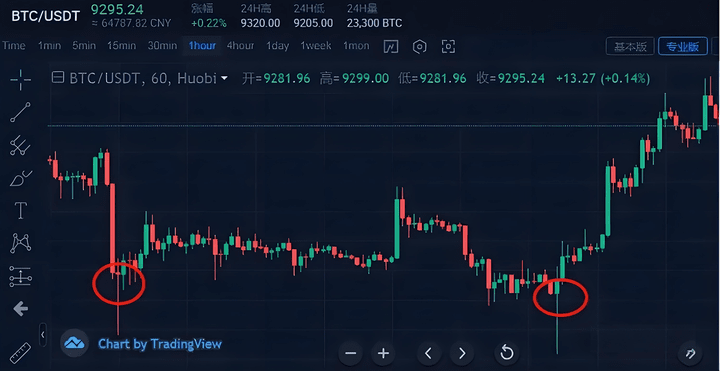
Likewise, let's analyze its principle: a shorter body indicates that the opening and closing prices are close, and a long upper shadow indicates that the price movement trend represents fierce competition between bulls and bears: the lower shadow reflects that during this process, the bearish forces are weakening while the bulls are gradually gaining strength. Regardless of whether the candlestick body is bearish or bullish, a bullish body indicates stronger bullish power, but even if it is a bearish body, it may seem that the price is falling, yet it represents a trend that is likely to reverse upwards. The longer the shadow, the more intense the bullish competition. When it appears at a stage bottom, it indicates a high probability of price rising.
However, if this pattern appears at the top, it becomes a hanging man. If it is followed by a bearish candlestick, it indicates strong bearish sentiment, and the probability of subsequent decline is high.
Other single candlesticks, such as the inverted hammer and the hammer, are similar to the shooting star and hammer, but their bullish or bearish signals are weaker than the latter.
The doji is more of a manifestation of the tug-of-war between bulls and bears. One should pay attention to the appearance of a doji at the interim tops and bottoms, as this may be a sign that the situation will change.
For example, at the top, if the upper shadow of the doji is long, similar to the shooting star, it indicates a high probability of a downward move; if at the bottom, a long lower shadow of the doji indicates a high probability of an upward move.
Now let's take a look at candlestick combinations.
A two-candlestick combination has the piercing line and the weaker signal morning star. If it appears at the bottom, it indicates a strong bullish signal; conversely, the piercing line and the evening star candlestick combination appearing at the top indicates a strong bearish signal. Further elaboration is unnecessary here.
The three candlestick combinations mainly include the morning star and evening star, with a bearish or bullish combination pattern interrupted by a candlestick representing a stalemate between buyers and sellers, such as the doji. When this appears at the top, it represents a strong bearish signal; when it appears at the bottom, it represents a strong bullish signal.
Alright, the above points are relatively basic candlestick knowledge, giving everyone an understanding. Next, we will delve deeper into market structure.
A single candlestick or candlestick combination is not the most important element for technical judgment; it is just a very local technical factor, which is not very operational in practice. Generally, we should not extract a single candlestick to judge the entire market situation.
We need to zoom out to analyze the overall market trend structure. When the overall and local resonate, its reference value will be very high!
For example, in a rising trend structure, if a long upper shadow shooting star candlestick appears at a key resistance area, it can basically be determined that this rise is coming to an end, also known as a single candlestick determining the trend or a special candlestick at a special position.
We have understood the local single or multiple candlestick combinations, and next, we will understand the overall market trend structure. Once we understand the language of the market, you will know 'where the market's wind is blowing.'
Market trend structure, simply put: it is connecting the peaks (high points) and valleys (low points) of the price movement on the candlestick chart to form a curve that fluctuates up and down. This helps us judge market trends.
The market trend structure can basically be divided into three types: uptrend; downtrend; consolidation.
We can make trend judgments through naked candlestick charts without relying on technical indicators.
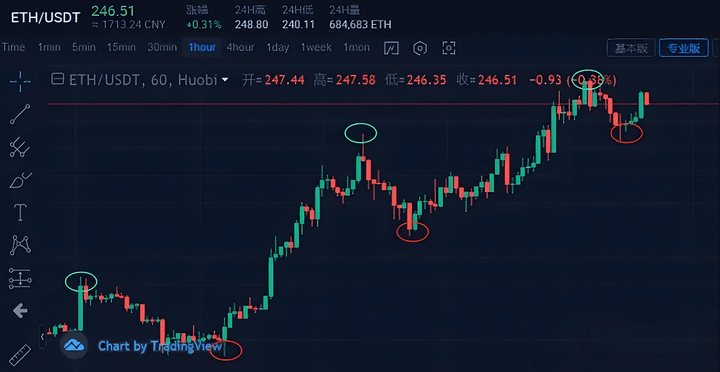
In a market that is in a trend, if it shows that the price highs (peaks) are continuously making new highs, while the price lows (valleys) are also continuously rising, then this is an uptrend.
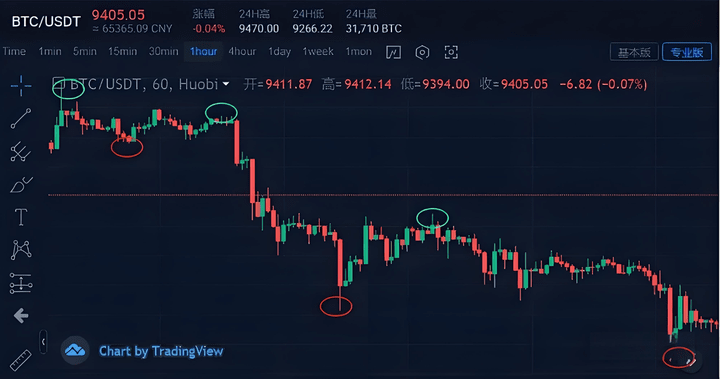
Conversely, if the price lows are continuously making new lows while the price highs are also continuously declining, then it is in a downtrend.
In such a one-sided trend market, trading will be easier, and going with the trend will be sufficient.
In an uptrend, the focus is on going long. The trading strategy you adopt is to buy low and not sell high, buying low during pullbacks and holding without easily selling high. Only when a turning point appears is it time to sell high. Among the many local highs during an uptrend, the real selling point is only the last one. This is about buying low and not selling high until the turning point appears.
In a downtrend, the focus is on shorting. The trading strategy remains the same: every rebound high can add to short positions, and short positions can be held until a trend change occurs.
Another state of no trend is a consolidation trend, which is characterized by prices fluctuating up and down within a certain range. You will find that prices touch a certain level multiple times before reversing, maintaining a fluctuation pattern back and forth within the range.
For oscillating trends, there will generally be upper and lower limit regions. Within the range, a strategy of buying low and selling high can be employed, selling high or shorting at the upper edge of the oscillation zone, and buying low at the lower edge until the oscillation zone is broken and trading strategies are changed.
Through the previous explanations, we have understood the classification of the overall market trend structure and strategies, clarifying the direction of trading (going long or short). The key is how to identify trend reversal points? This will change trading strategies, and this is the focus of our next discussion.
Once we understand the market trend structure, the next thing to do is to find a suitable entry point (to short or go long). The price often reverses at that point.
The obvious support or resistance levels on the naked candlestick chart can be recognized visually; the support level is the buying point, and the resistance level is the selling point.
Let me teach you the simplest method: just draw horizontal lines on the naked candlestick chart.
We mentioned earlier that candlesticks reflect the tug of war between bulls and bears. The sellers represent the bearish forces (those holding chips), while the buyers represent the bullish forces (those holding cash). The resistance during the price rise comes from profit-taking selling, as well as the selling pressure from trapped chips.
So where are the trapped chips?
Looking back at the obvious peak positions, they are basically areas of dense trading, indicating that they are areas of trapped chips. Once the price recovers to that area, the selling pressure from the bears increases significantly, causing the price to drop. This is the reason for price declines.
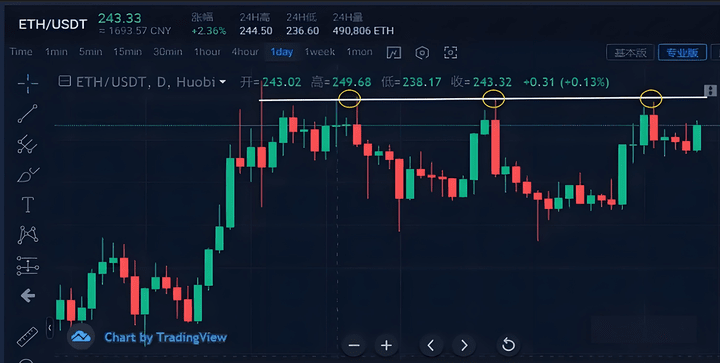
For example, in the above image, we take the daily trend of ETH on July 14 as an example.
By drawing a horizontal line at the peak position, it's very simple to determine that the area around 250U is a strong resistance zone. In the following instances, every time the price reaches this area, it shows a retracement, caused by the selling pressure of the trapped chips.
So, in the future, only after breaking through this position can it transform into a support level.
Similarly, for support during a downtrend, look for obvious valley positions ahead. This is the cost level for bulls holding positions. Once the price retreats to this level, the bulls will defend the cost level, increasing bullish force, which will lead to a price rebound.
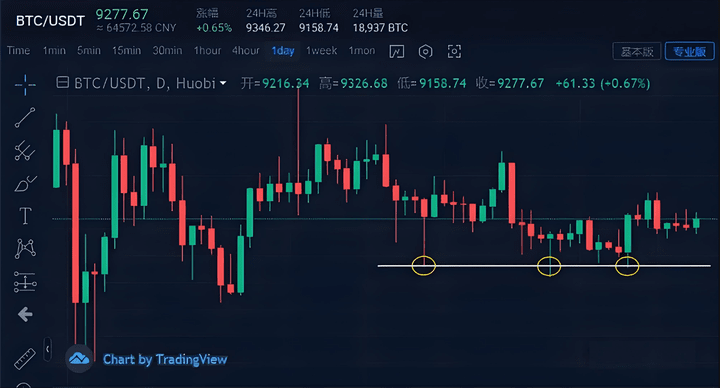
For example, the BTC daily chart shown above.
On the daily chart, we can see that several retracements around 8910 led to rebounds. By looking at the valleys, we can easily draw a horizontal support level. If you want to participate in a low buy operation, just keep an eye on this horizontal line, which can be analyzed visually through naked candlesticks.
It is important to note that support and resistance levels can switch. If a resistance level is broken, it will form support for future price pullbacks. Similarly, if a support level is breached, it will form resistance for future price rebounds.
Market trend structure advances in a wave-like manner. The main force conducts a washout during the upward surge, and the price will drop. When the price pulls back to the previous high point, once the previous high is broken, it becomes support.
A simple principle: if the main force has washed you out at the previous high, then the price will not fall below your previous exit point, otherwise, it defeats the purpose of washing out. Therefore, a pullback to near the previous high is your best opportunity to enter the market.
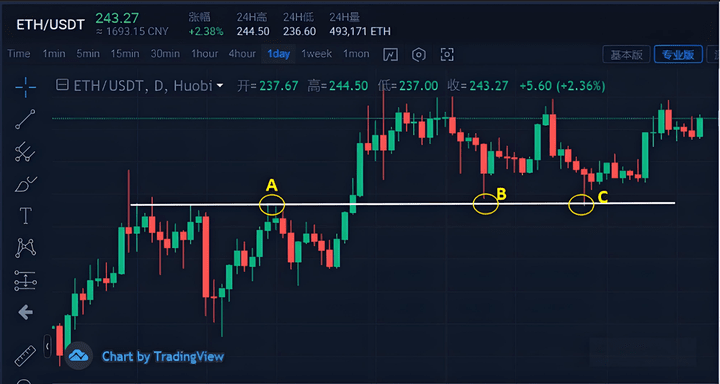
Let's look at ETH's movement at that time, as shown in the image above.
In the chart, point A represents a peak position. Once this peak is broken, it will convert into support.
Looking at the subsequent adjustments, the lowest point at position B in the image basically stopped falling just above price A and did not continue to drop. After the main force washed you out earlier, the subsequent adjustments will not give you another opportunity to enter at a low price, so there is no need to continue to drop.
Similarly, the adjustment at point C also stopped falling just above point A.
By using naked candlestick market trend structure, after understanding the price's support and resistance levels, we can combine these special positions with special candlestick signals for comprehensive analysis, such as the reversal candlestick patterns we discussed earlier.
For example, at a strong support level (valley) when a hammer candlestick reversal signal appears, this bottom signal is quite strong, and the probability of succeeding in going long is very high.
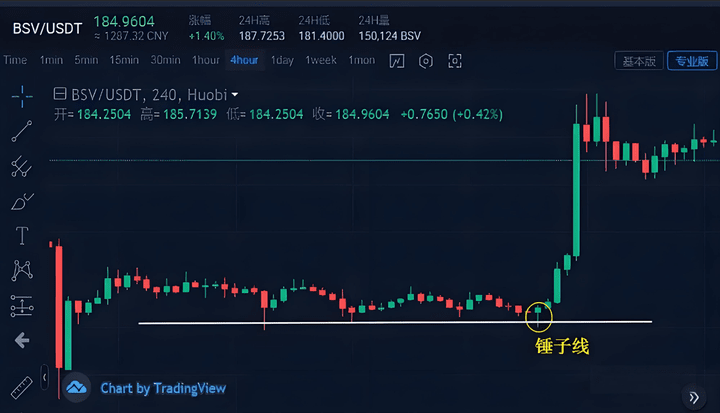
As shown in the image, BSV's strong upward movement in early July.
On the 4-hour level, we can draw a horizontal line through the valleys to clearly analyze support levels.
When a reversal candlestick pattern appears at the support level, a hammer candlestick reversal pattern appears at the circled area in the image. At this time, participating in going long can yield significant profits.
Similarly, when we identify a resistance zone through the peaks of naked candlesticks, combined with key reversal candlesticks at critical positions, if a shooting star or other reversal signals appear, then this position is a good opportunity to short.
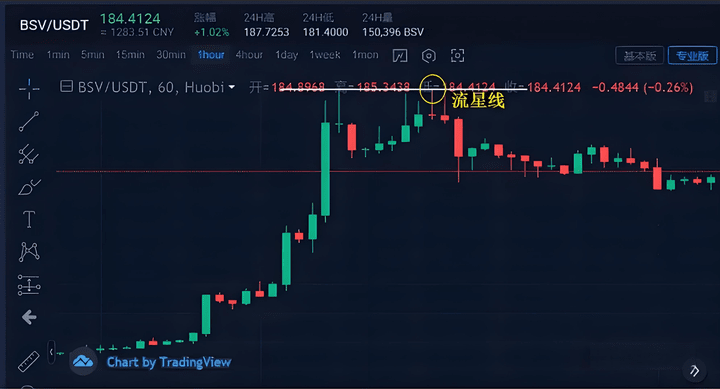
We will also take BSV as an example, as shown in the image above.
For BSV on the hourly level, drawing a horizontal line at the peak can reveal the resistance zone.
At this special critical position, a shooting star appeared, and two shooting stars followed in succession, at the circled area in the image.
This indicates that the bearish force here is very strong, and you can participate in shorting in the direction of the trend. You can grasp the subsequent space for this wave of selling.
Of course, at special critical positions, analyzing through special reversal candlesticks is one method. Trend lines, Fibonacci retracement, etc., are also good analytical methods.
For contract trading, a complete trading system is very important. Generally, this system will include: position size, direction (long or short), entry point, take profit point (when to exit with profit), stop loss point (when to exit with loss), countermeasures (for emergencies), and risk control, etc.
Through the naked candlestick techniques we discussed earlier, and integrating this trading system, we ensure the success rate of each operation.
Generally, for highly uncertain opportunities, the position should be controlled within 20% to avoid heavy speculative trading. Of course, we pursue the success rate of each operation, so if there is no certainty, it is better to wait, and participate in the position when an opportunity is discovered.
The myth of becoming rich might be distant, but those who control the rhythm can steadily pocket their profits. If you have ever felt lost, anxious, and scarred in the market, you might as well try this set of rhythms.
Calm down and see the road clearly.
Stop when you need to, move when you should.
Don't rush, take it slow.
Your path to doubling your investment may truly begin from the moment you gain control of the rhythm.
Even the most diligent fisherman would not go out to sea during a stormy season, but would carefully protect his boat. This season will eventually pass, and a sunny day will come! Follow me, and I will teach you both fishing and how to fish. The cryptocurrency market's door is always open. Going with the trend is the only way to live a life of success. Save this and remember it in your heart!